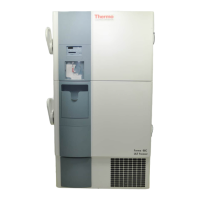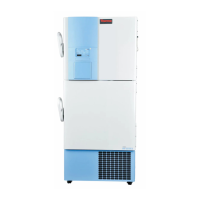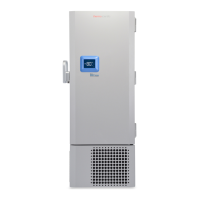Do you have a question about the Thermo Scientific Forma 8600 Series and is the answer not in the manual?
Crucial safety and operational guidelines for initial setup and use.
Details of components included with the freezer unit.
Contact details and services offered for product inquiries and technical assistance.
Explanation of the control panel interface, buttons, and display elements.
Identifies and describes the various display indicators on the freezer's control panel.
Step-by-step instructions for safely removing and positioning the freezer.
Guidelines for selecting an optimal and safe placement for the freezer.
Procedures for attaching protective wall bumpers to the freezer unit.
Details on connecting the freezer for data transfer using the RS-232 serial interface.
Information on connecting external alarm systems and analog signal outputs.
Steps for securely connecting the freezer's power cord to the unit.
Procedures for safely connecting the freezer to a suitable power source.
Steps for powering on and preparing the freezer for operation.
Instructions on how to adjust the primary temperature set point for the freezer.
Configuration of the upper limit alarm for freezer temperature monitoring.
Configuration of the lower limit alarm for freezer temperature monitoring.
Setting a security code to prevent unauthorized access to freezer settings.
Description of the normal operating mode and its displayed information.
Introduction to the calibration mode for system parameter adjustments.
Step-by-step guide for calibrating the primary temperature sensor.
Recommended waiting times for temperature stabilization before calibration.
Verifying the functionality of the high temperature alarm system.
Verifying the functionality of the low temperature alarm system.
Performing a diagnostic test on the freezer's internal system battery.
Performing a diagnostic test on the Back-Up System (BUS) battery.
Choosing which temperature reading is shown on the main display.
Procedure to reset the high stage alarm after a condition is resolved.
Steps to set or change the security access code for configuration menus.
Assigning a unique address for RS485 communication.
Selecting the gas type (CO2 or LN2) for the optional back-up system.
Displaying the coldest temperature recorded by the control probe.
Displaying the warmest temperature recorded by the control probe.
Clearing recorded cold and warm excursion temperature data.
Alarm for high stage compressor/fan issues in -86C models.
How the system displays and handles multiple simultaneous alarm conditions.
Troubleshooting indicator for internal communication failure with the micro board.
Alarm triggered by loss of communication between micro and display boards.
Instructions for cleaning or replacing the air filter for optimal performance.
Procedure for cleaning the freezer's condenser coils to ensure efficient operation.
Step-by-step process for defrosting the freezer's interior.
Maintenance steps for the freezer lid gasket to ensure a proper seal.
Detailed instructions for replacing the internal battery for specific freezer models.
Procedure to test battery voltage and determine if replacement is needed.
Steps to take when preparing the freezer for extended periods of non-use.
Recommended routine maintenance tasks and their frequency for freezers.
Introduction to the built-in back-up system for maintaining temperature during power failures.
Steps for installing the gas injection tee assembly for the BUS.
Procedure for routing and securing the temperature probe for the BUS.
Wiring instructions for the probe and solenoid components of the BUS.
Description of the BUS control panel indicators and functions.
Instructions for setting up the BUS for LN2 or CO2 gas.
Adjusting the temperature threshold for BUS activation.
Procedure to verify the functionality of the Back Up System.
Steps for safely disconnecting the freezer from its gas supply.
Overview of the chart recorder's function and operation.
Instructions for loading new paper into the chart recorder.
Procedure to modify the temperature range settings for the chart recorder.
Steps to ensure accurate temperature readings from the chart recorder.
Information regarding compliance and regulatory approvals for the product.
Operating limits and environmental conditions for safe and effective use.
Defines the approved applications and limitations for the freezer.
Details on the types and amounts of greenhouse gases used in the product.
Details of the standard warranty coverage for the freezer unit.
Warranty specifics for units sold through international distributors.
Critical precautions and procedures for safely working with liquid nitrogen.
Recommended personal protective equipment for handling cryogenic materials.
Basic hazards and properties of liquid nitrogen relevant to safe usage.
Guidelines for selecting and using appropriate containers for liquid nitrogen.
Importance of proper venting for cryogenic containers to prevent pressure buildup.
Methods and tools for safely transferring liquid nitrogen between containers.
Instructions to avoid overfilling cryogenic containers to prevent spills.
Warnings against using incorrect tools for measuring liquid levels.
Requirements for storing and using liquid nitrogen in well-ventilated environments.
Guidelines for safely disposing of excess liquid nitrogen.
Guidelines for storing and using liquid carbon dioxide in well-ventilated areas.
Procedures for safely disposing of excess liquid carbon dioxide.
| Brand | Thermo Scientific |
|---|---|
| Model | Forma 8600 Series |
| Category | Freezer |
| Language | English |











